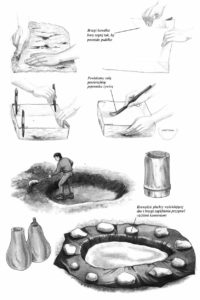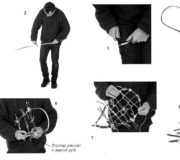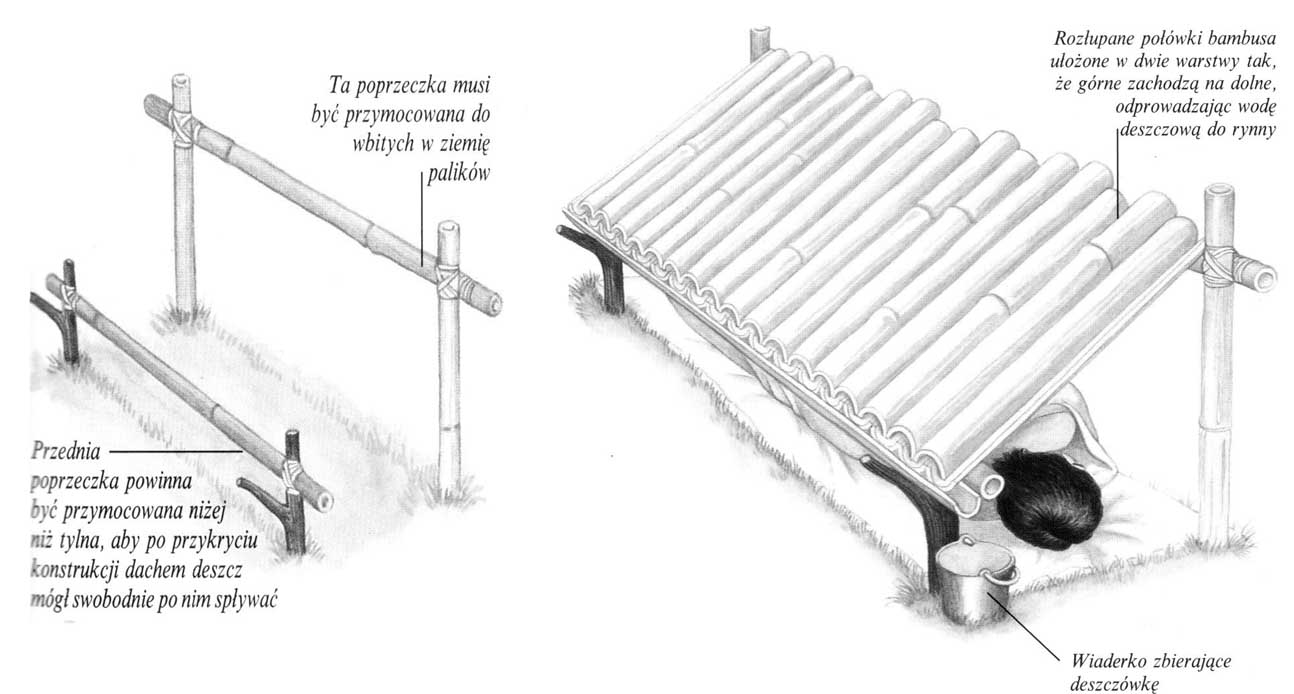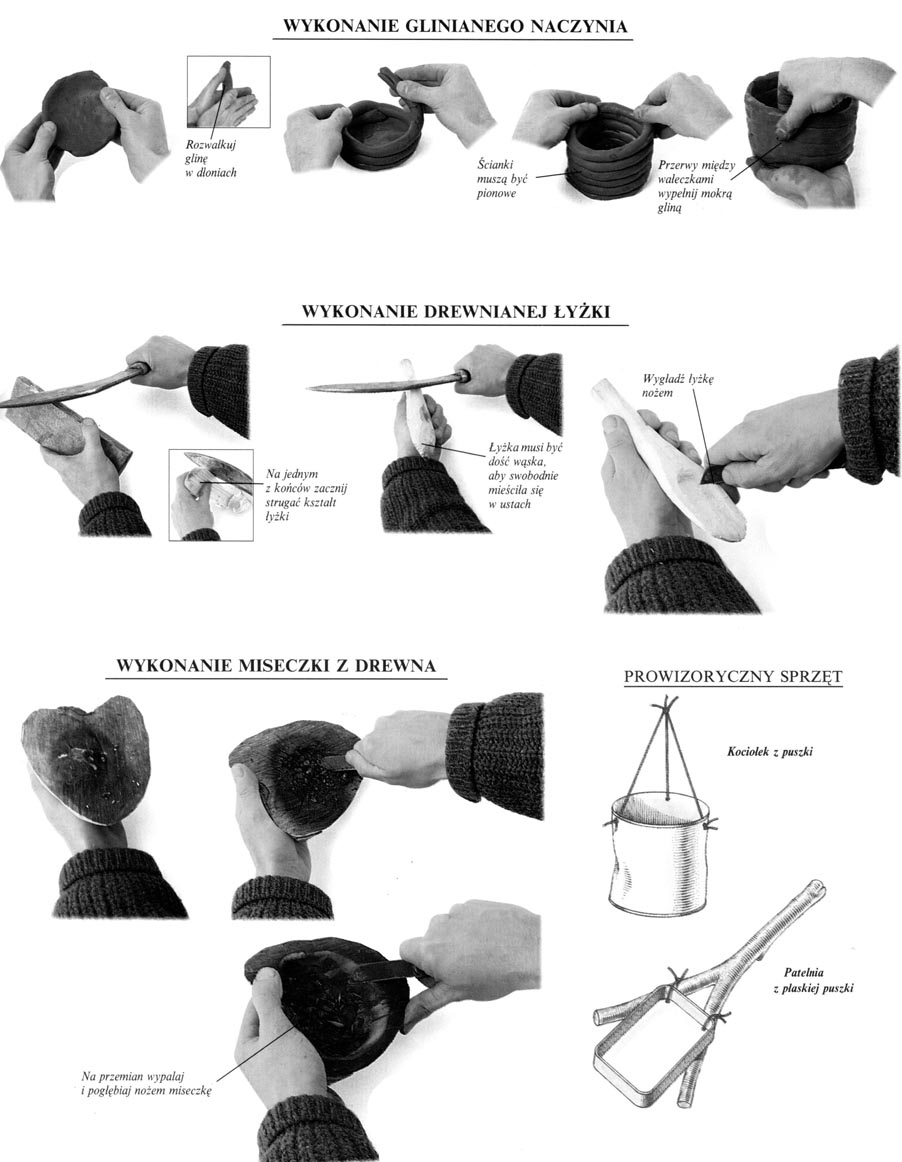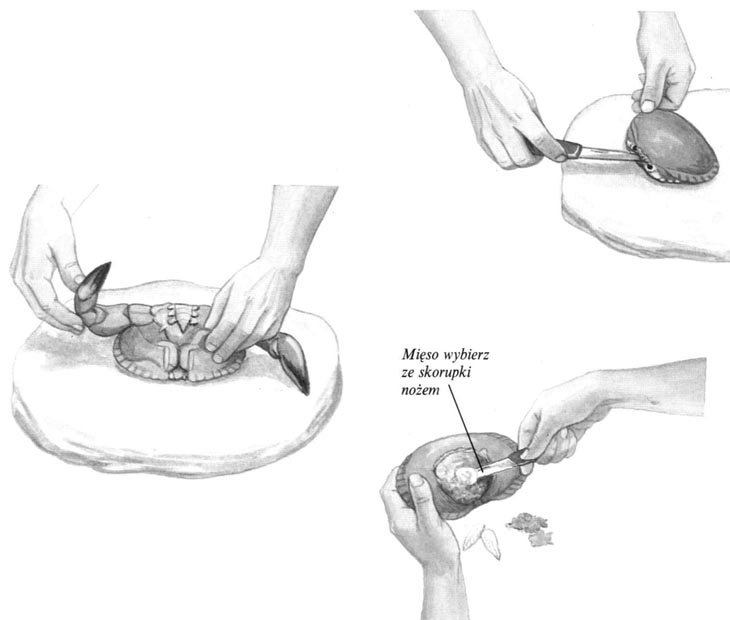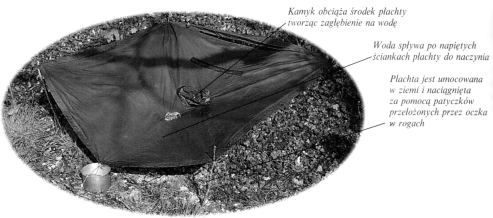Pojemnik z kory
1 Możesz wykonać prowizoryczny pojemnik na wodę z giętkiej, zielonej kory, na przykład z brzozowej. Wytnij najpierw prostokątny kawałek kory.
2 Nasącz rogi wodą, żeby zmiękczyć korę i delikatnie zagnij brzegi, tak jak na rysunku.
3 Z rozszczepionych patyczków zrób szczypce przytrzymujące rogi pudełka. Sklej jego boki żywicą sosnową, którą można zdrapać z kory drzewa. Rogi trzymaj ściśnięte patyczkami do czasu, aż żywica wyschnie.
4 Po wyschnięciu żywicy usuń patyczki. Potem posmaruj wnętrze pojemnika żywicą sosnową. Do smarowania używaj pędzla z gałązki z rozszczepioną końcówką. Odstaw pudełko do wyschnięcia.
PROWIZORYCZNE POJEMNIKI
Bambusowe kubki
Łodyga bambusa podzielona jest na odcinki węzłami. Tworzą one przegrody, dlatego łodyga składa się jakby z oddzielnych, zamkniętych komór, które znakomicie nadają się na naczynia. Łodygę bambusową trzeba uciąć 2 cm poniżej jednego węzła, a potem również około 2 cm poniżej drugiego. W ten sposób powstanie kubek z przegrodą jako dnem.
Tykwy
Tykwy lub dynie po wydrążeniu miąższu są znakomitymi naczyniami. Zetnij czubek tykwy, potem nożem lub patykiem wybierz ze środka miąższ. Zrób to dokładnie pozostawiając samą zdrewniałą okrywę.
MAGAZYNOWANIE
1 Jeśli, na przykład, chcesz zebrać zapas wody w porze deszczowej, by przetrwać porę suchą, lub wtedy gdy potrzebujesz dużych ilości wody, musisz ją umieć zgromadzić.
Wybierz najpierw miejsce, w którym zbiera się woda gruntowa, na przykład naturalne zagłębienie w ziemi, i pogłębiaj je, aż dotrzesz do gliny lub twardej skały.
2 Wyłóż dno i brzegi dołu impregnowaną płachtą lub wyklej wilgotną gliną tak, by powstała nie przepuszczająca wody powłoka. W dzień przykrywaj zagłębienie brezentem lub gęsto utkaną matą z gałązek, aby zmniejszyć parowanie. Na noc i w czasie deszczu zdejmuj matę lub płachtę. Powoli zagłębienie wypełni się deszczówką oraz osadzającą się na dnie rosą. Uzupełniaj regularnie zapas wody pamiętając, że część stale wyparowuje.
PRAKTYCZNE WSKAZÓWKI
■ Zawsze przed wypiciem wody z naturalnego źródła przefiltruj ją i odkaź.
■ Staraj się gromadzić tyle wody, by zaspokoić dzienne zapotrzebowanie organizmu i mieć jeszcze niewielki zapas.
■ Podczas deszczu rozstaw możliwie jak najwięcej naczyń do łapania deszczówki.
■ Szanuj wodę. W czasie przelewania staraj się jej nie rozlewać, nigdy jej nie marnuj, choćby w danym momencie było jej dużo. Pamiętaj, że w każdej chwili może jej zabraknąć.
■ Nigdy nie pij moczu lub wody morskiej bez uzdatnienia. W sytuacjach krytycznych możesz z nich wydestylować wodę pitną.
■ Pij dużo wody również wtedy, gdy jest zimno. Aktywny wysiłek fizyczny, na przykład torowanie drogi w śniegu czy jazda na nartach, powoduje wydzielanie dużych ilości potu. Jeśli straty wody nie będą uzupełniane, organizmowi grozi odwodnienie.
■ Nie jedz dużo, jeśli nie masz wody, ponieważ jest ona niezbędna w procesie trawienia; po jedzeniu będziesz czuł wzmożone pragnienie.
